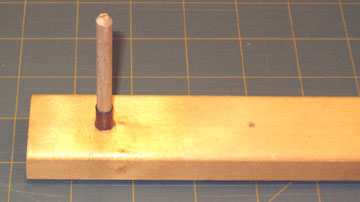Preparing the Wheels for Paint
New tires usually don't look right on a scale model. I normally thread
a bolt through the wheel, lock it with a nut, chuck the assembly into a drill and then sand the
perimeter with fine sandpaper to remove molding seams in the tire and to
make the tire look slightly worn.
I also "wet sanded" these tires using 0000 steel wool with soapy water.
All of this is easiest to accomplish with the tires still on the hubs and
before painting.
When you are finished with the tires remove them from the hubs if possible. I spent a few minutes trying to find a way to remove the
tires from the hubs of the Williams Bros wheels. I don't
believe they can come off without damaging anything but I could be wrong.
In any case, I resigned myself to painting the hubs with the wheels in place
which makes things a little more difficult.
Wheel hubs are almost always molded plastic. More often than not there
are molding and manufacturing imperfections that should be corrected before
painting.
For example, injection molded parts are attached to sprue which is basically
a tunnel the molten plastic flows through on its way to the mold. Unfortunately
the people who remove the parts from the sprues often twist the parts off
which usually removes a chunk of plastic. Use a good putty or make
your own to fill imperfections.
I mixed some talc into 30 minute epoxy and used a wet finger to smooth it
into the blemished area. The next day I sanded the filler to match the
rim. In this case the repaired areas are gray. I
used wet or dry paper with which I had previously sanded aluminum. I
didn't worry about the stains because they are on the rims and will be
painted with aluminum metalizer.
Other than sprue marks and flash there usually aren't too many defects on
the wheels I've seen. Flash is the thin plastic around the edge of a
part. It is plastic that flowed between the two mold halves.
This can be scraped off easily with a hobby knife.
After the plastic is as blemish-free as you can make it you must
meticulously clean the wheels in preparation for paint. Wash them
throroughly in a good degreaser that won't harm plastic. Tri-Sodium
Phosphate is an excellent degreaser and safe for plastic. Do not use
dishwashing detergents. These often contain chemicals that make water
sheet off dishes. This same chemical can make your paint fisheye.
Rinse the wheels thoroughly and then shake off the excess water. Do
not wipe water off with a cloth or paper towel. Both of these items
will leave lint on the plastic and create static electricity that attracts
more dust.
Slip the wheels
over a dowel hanging over a shelf until they are dry. Be sure they are
thoroughly dry before you attempt to paint. Often water gets between
the tire and the hub taking days to dry. The last thing you want is
water to seep out and run across your wet paint —
or worse — seep out while you're spraying thus
becoming trapped under the paint which creates blisters in the paint and
pretty much ruins it.
Avoid touching the plastic with your bare hands after you clean it. Skin oils can affect
paint adhesion as well as cause fisheyes. In this case I handled the
wheels only by the tires.
 |
I made a painting jig in hopes that it would greatly
simplify painting the rim. The idea is to place the wheel over the
axle, place the paint filled brush against the rim and then turn the
wheel and come out with a perfect circle. The wheels I painted
have a brass bushing glued in the hub. The brass tube at the base
of the dowel
prevents the wheel from contacting the wood and rubbing the paint from
the hub. |
|
![]()